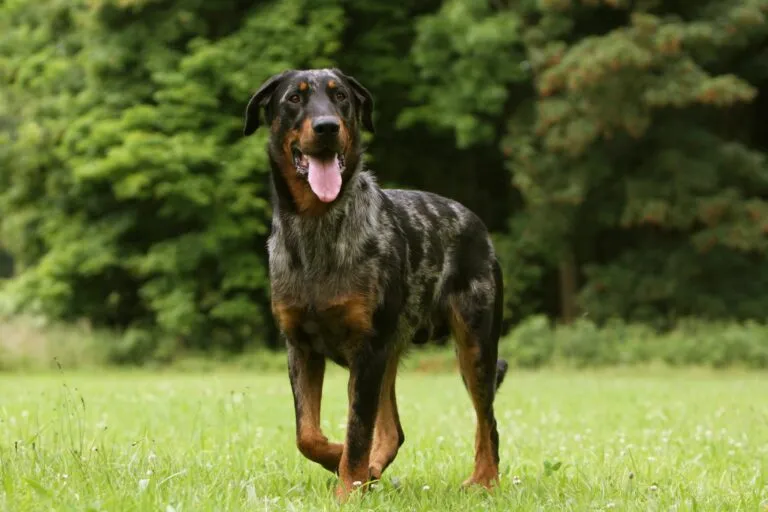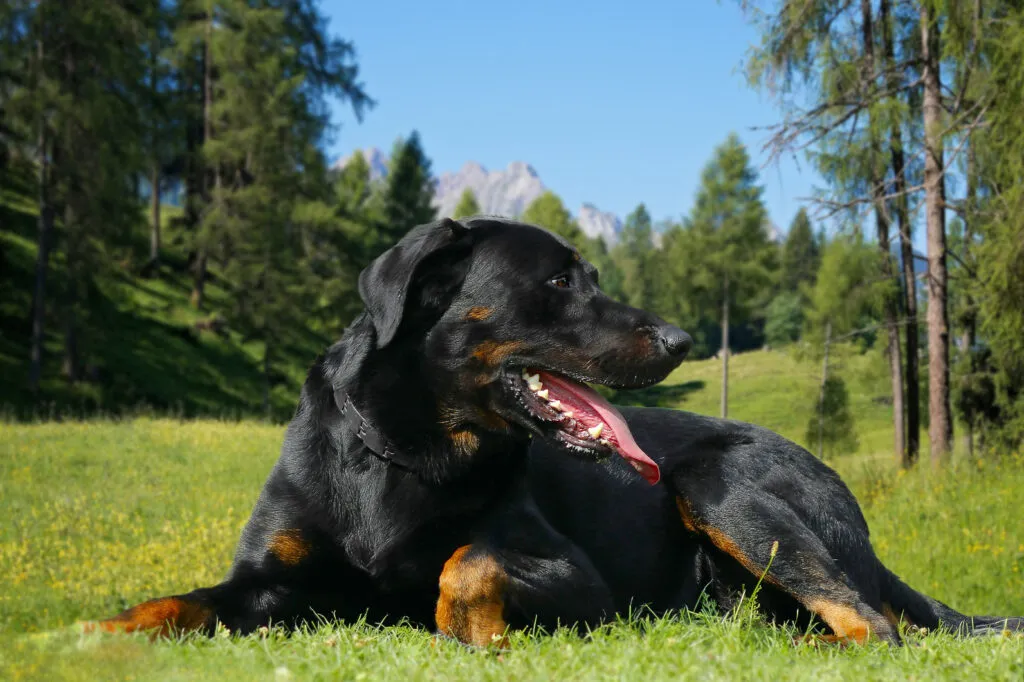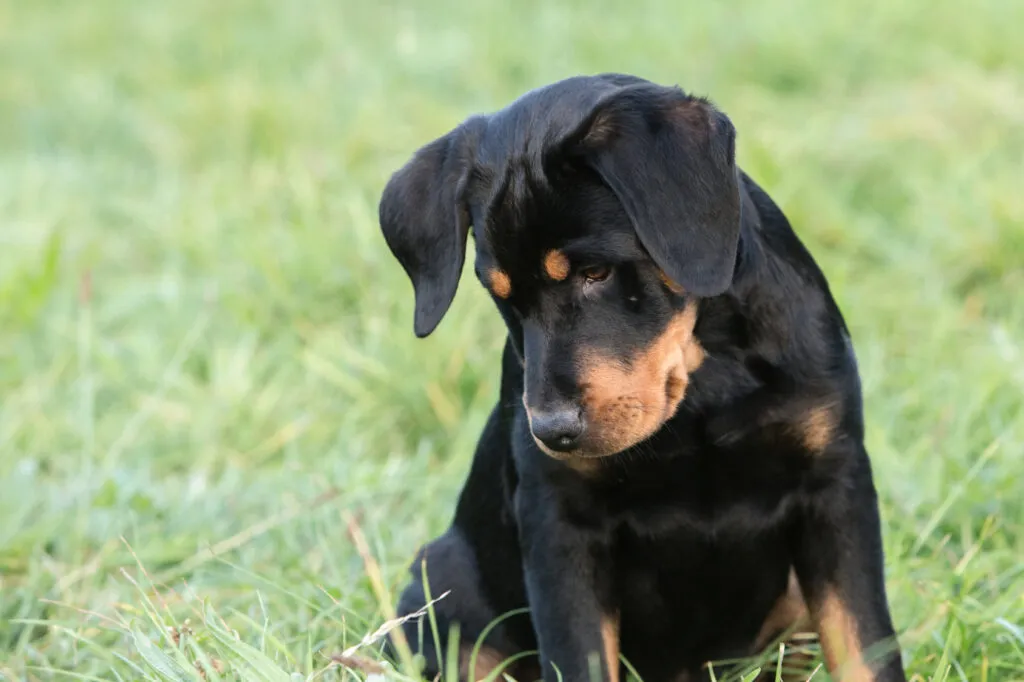Medium Size Poodle
The robust Beauceron with its short, dense fur needs an experienced dog owner due to its self-confident and dominant nature. This owner should raise the dog with lots of love and consistency.

© Dogs / stock.adobe.com
The Beauceron was originally bred as a herding dog
With such a courageous and fearless watchdog by your side, danger seems distant. Most people would likely avoid a confrontation with a Beauceron. With a shoulder height of up to 70cm for males, a weight of up to 50kg, and a strong yet sporty build, the Beauceron cuts an impressive figure. Its (semi-)upright ears and alert eyes give it a confident and attentive expression.
The short fur with its dense undercoat protects the robust breed from all weather conditions. The Beauceron comes in three colour variations:
In all three colour types, the paws are tan, earning it the nickname “Bas Rouge” (Red Stockings).
Just as characteristic are the Beauceron’s double dew claws, set deep to enlarge the foot surface. As a herding dog, these offered it extra grip, for example, when walking on sand or across penned sheep. Though these claws are no longer necessary today, they remain a mark of the breed’s purity and a distinctive feature.
The French breed certainly doesn’t lack self-confidence. As a former herding dog, capable of managing a herd of 200 to 300 animals and protecting both shepherd and flock fearlessly, this trait is well-deserved. The independence associated with this role, explicitly desired by early breeders, is now often interpreted as wilfulness, stubbornness or even obstinacy. The Beauceron does indeed have a certain dominance, necessitating a firm hand.
Despite its dominant nature, this dog loves its family and especially its “pack leader” deeply. If the owner understands the dog’s quirks and provides it with plenty of love, consistent training, and lots of exercise and activity, they will gain an incredibly loyal and reliable companion who will defend them at all costs in an emergency. A well-trained and mentally and physically stimulated Beauceron proves to be easy to handle and obedient. It follows commands quickly and completes its tasks with infectious enthusiasm.
While the Beauceron’s high energy level and impressive endurance benefit its training, they also require active and confident owners who can keep up with this energetic dog. Without enough stimulation, its innate herding instinct and independence can become problematic. In some countries, the breed is therefore listed as dangerous, requiring a special permit for ownership.
Whether working as a herding dog, a service and protection dog for the police, or a rescue dog, this intelligent and agile dog should certainly be involved in dog sports. Playing outside and taking on new challenges doesn’t just help balance the dog but also strengthens the bond between it and its owner.
Although closely bonded to its human owner, the Beauceron is always cautious around strangers. Rather than barking loudly, it watches strangers from a distance. This watchful guardian misses nothing and is always ready to confront an attacker fearlessly. Once convinced there is no danger to its family, it will willingly accept pets from strangers—provided it recognises its owner as a capable pack leader whose judgement it trusts.
 © jandix2 / stock.adobe.com
© jandix2 / stock.adobe.com
When selecting a puppy, it’s vital that the animals have all necessary papers and vaccinations, and have undergone all recommended health examinations. Unlike many other breeds, the Beauceron typically has no breed-specific health issues. Having avoided the fate of many “fashion dogs”, the Beauceron has retained its robustness and resilience from its herding days. Nevertheless, hip or elbow dysplasia (HD, ED), gastric torsion, or epilepsy can occur in individual cases.
To avoid joint issues, gastric torsion, or other health problems, a healthy and balanced feeding regimen is crucial. It ensures your dog gets all essential nutrients and minerals, fostering good development and lifelong agility.
Since nutrient needs vary from dog to dog and depend on exercise, age, and weight, there is no one-size-fits-all answer. Consult your vet, breeder, or a canine nutritionist to determine the best food for your Beauceron.
For a healthy adult dog, the food should meet these basic requirements:
It’s advisable to split the daily food portion into two meals. Your dog will quickly adjust to these set times and stop begging between meals. Avoid too many treats to maintain your dog’s weight. Fresh drinking water should always be available.
Fixed times aren’t just useful for meals but also for your dog’s care. It’s best to get your dog used to necessary care rituals early on. Regularly check and clean your dog’s coat, ears, claws, teeth, and gums. Despite the short, hard coast, it’s enough to wipe the coat with a cloth once a day. Clean ears, teeth, and gums weekly. Claws (including dew claws) should be trimmed regularly to prevent injuries.
Start these care routines early and consistently so your dog learns to stay still. Cleaning the teeth of an adult Beauceron that isn’t used to it can be quite challenging.
The Beauceron is a large and very strong dog, requiring a strong hand to manage its energy. Its owner should be able to keep up with the dog both mentally and physically. While it’s rare to find an owner capable of covering 100km daily like a Beauceron, they should have enough endurance and power to give the dog sufficient exercise and keep it on the lead when needed.
As a former working dog accustomed to covering long distances taily and performing tasks with great enthusiasm and independence, the Beauceron still needs plenty of exercise and activity. Training as a service or protection dog, in search and rescue, or for avalanche and disaster missions is ideal for this versatile and hardworking dog.
Thankfully, it also enjoys a variety of dog sports to stay engaged and happy. From obedience to agility or mantrailing, the quick, agile, and intelligent Beauceron is a perfect fit for almost any dog sport. It also enjoys accompanying its owner while jogging, cycling, or horse riding. However, don’t forget that regular mental stimulation is equally important.
A physically and mentally stimulated dog doesn’t seek its own tasks and integrates more obediently into the family. Though the Beauceron is said to be challenging to train, this isn’t entirely true. The dog is keen to follow its owner’s commands and learns quickly, provided it gets enough activity and exercise. Harsh methods or a “heavy hand” are not tolerated; even minor “slips” will not be easily forgiven by this proud dog.
Indeed, keeping a Beauceron demands much power, expertise, and consistency in training, as well as sensitivity in dealing with the demanding dog and knowing when to allow it some rest. After all, relaxation benefits both you and your dog.
 © Eric / stock.adobe.com
© Eric / stock.adobe.com
The Beauceron’s history is closely linked to the old nomadic shepherding practices of France. Until the 19th century, a variety of herding dogs were crossbred based on utility for shepherding. As nomadic shepherding declined with industrialisation, the versatile and brave Beauceron found its role guarding and protecting farm property.
Although the breed’s ancestors were mentioned in medieval times, the Beauceron as we know it today emerged in the late 19th century. Its standardisation is closely tied to the Briard. Until then, these dogs were considered a single breed. In 1888, French cynologist and veterinarian Pierre Mégnin differentiated them. The newly formed “Club Français du Chien de Berger” created separate standards for the long-haired “Chien de Berger de Brie” (Briard) and the short-haired “Chien de Berger de Beauce” (Beauceron).
Shortly after the founding of the first specialist club “Club des Amis du Beauceron” (Club of Beauceron Friends), the breed was recognised by the Fédération Cynologique Internationale (FCI) and remains listed under standard number 44, group 1 (herding and driving dogs).
The Beauceron, also known as “Chien de Beauce” based on its geographic origin, is primarily found in France and neighbouring Belgium. Each year, around 3,000 to 3,500 Beauceron puppies are registered in its native land. Since 2007, the breed has also been officially recognised by the American Kennel Club (AKC). Outside of France, however, the Beauceron remains a rare breed.
If you’re interested in a Beauceron, be aware that a healthy puppy isn’t available overnight. The decision to buy this breed should be well considered, and choosing a suitable breeder should be done carefully. Waiting several months for a Beauceron puppy from a healthy line is normal. If you are convinced this breed is right for you and can provide what this demanding dog needs, your patience will pay off.
Registered breeder addresses can be found at the relevant Beauceron breed club. However, being registered doesn’t automatically mean the breeder is right for you. Unlike buying a car, you will ideally maintain contact with your breeder after purchasing your puppy. Experienced breeders will gladly provide advice and valuable tips on feeding, training, and your dog’s health.
Therefore, the breeder should also be likable. Visit several breeders—and even if the first impression is good, visit a few times before taking a puppy home. A good breeder will welcome you, answer your questions, and show you their breeding facilities and animals. Don’t be surprised if the breeder asks you questions too—a passionate breeder wants to ensure their beloved dogs go to good homes.
Fans of the Bearded Collie agree that those who aren't familiar with this dog breed simply have to get acquainted with it. And those who have experienced how a Bearded Collie bolts across meadows with its flowing fur, how it rolls around full of energy and joy and how it attentively and observantly takes into account its owners wishes become simply addicted to this original dog breed and its unique charm.
The Goldendoodle isn't a breed, but a pairing between Golden Retrievers and Medium or Standard Poodles. Marketed as a low-maintenance dog for allergy sufferers, this hybrid is enjoying increasing popularity amongst dog lovers, similar to the Labradoodle.